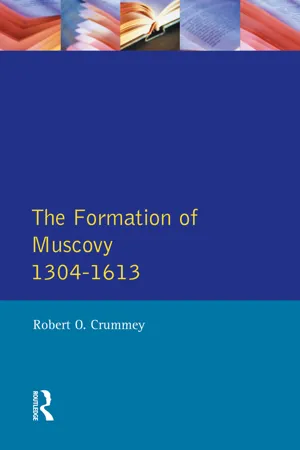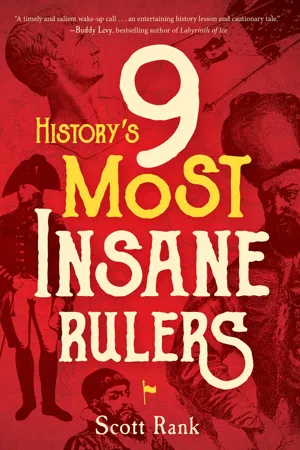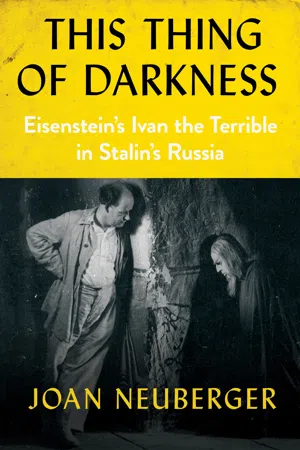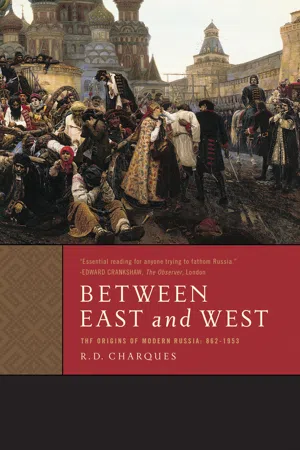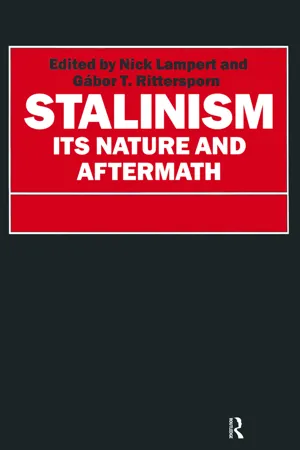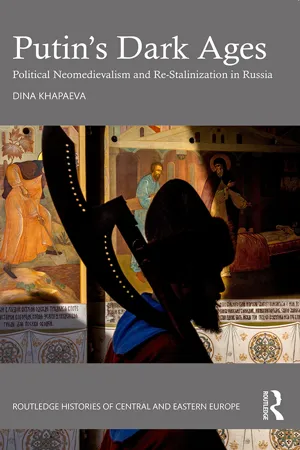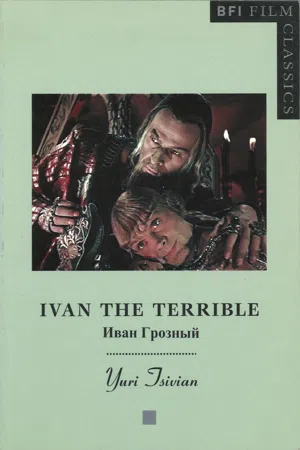History
Ivan The Terrible
Ivan the Terrible, also known as Ivan IV, was the first Tsar of Russia. He is remembered for his complex and often brutal reign, marked by significant military conquests and internal reforms. Ivan's rule was characterized by his erratic behavior, including the infamous "oprichnina" period during which he unleashed a reign of terror on his own people.
Written by Perlego with AI-assistance
Related key terms
Related key terms
1 of 4
Related key terms
1 of 3
9 Key excerpts on "Ivan The Terrible"
- eBook - ePub
- Robert O. Crummey(Author)
- 2014(Publication Date)
- Routledge(Publisher)
CHAPTER SIX The reign of Ivan The TerribleThe reign of Ivan IV, the Terrible (1533–84), was a time of great accomplishments and ruinous disasters for the ruler of Moscow and his subjects. Ivan’s government continued the mobilization and consolidation of the nation’s resources, particularly through creative reform of the royal administration and armed forces. In war, he used the weapons forged by his predecessors – a powerful army, a solid diplomatic position and a sense of national mission – to win brilliant victories. What began so well, however, ended in tragedy. By the end of Ivan’s life an aggressive foreign policy led to humiliating defeat, domestic reform had degenerated into a bloody reign of terror, and serfdom had begun to swallow up the Russian peasantry.The reign, then, presents us with a mixed pattern of light and shadow, of triumph and tragedy. Since Ivan’s own time, observers have wrestled with a single question more than any other. To what extent does the motley pattern of triumphs and setbacks mirror Ivan’s own personality? Historians have long been tempted to see Ivan IV as a ‘Renaissance prince’, a brilliant, complex and mercurial ruler, like Henry VIII, who was exhilarated and burdened by the demands of his office.1In recent times, however, this traditional picture has come under attack. Historians who attempted to portray Ivan’s personality and outline his ideas on government relied heavily on his exchange of letters with Prince A. M. Kurbskii, a Muscovite aristocrat who deserted to Lithuania. Edward L. Keenan, however, has argued that these documents are not genuine, but instead the invention of a seventeenth-century writer or writers.2 From that point, Keenan has gone on to sketch quite another picture of Ivan – that of a chronic invalid, incapacitated by the drugs and alcohol with which he deadened the pain of a chronic disease. He was no intellectual on the throne; indeed, he may not have been literate. Given his physical and mental limitations, he could not possibly have played a leading role in the conduct of governmental affairs which, fortunately for Russia, usually fell into the hands of his advisers.3 - eBook - ePub
- Scott Rank(Author)
- 2020(Publication Date)
- Regnery History(Publisher)
USSIAN TSAR IVAN THE TERRIBLE 1530–1584C alled “the Great” by advocates and “the Terrible” by opponents, Ivan IV Vasilyevich ruled Russia for fifty-one years as crown prince and then tsar. He rightfully earned both sobriquets. Ivan The Terrible used ironhanded policies guided by perpetual paranoia to terrorize subjects, execute rival aristocratic factions, and pillage entire cities for suspected treason, all to centralize his administration and end checks on absolute power. Legends abound of his sadistic delight in his enemies’ painful deaths—for example, he had monks sewn into bearskins and thrown to hungry dogs. Others claim he gratified his insatiable lust with dozens of women who joined the tsar on military expeditions to satisfy him at whim.Yet even Ivan’s strongest detractors do not deny he was also Great. The Russia of Ivan’s youth was the Duchy of Muscovy, a minor Eurasian state at the mercy of more powerful European and Central Asian empires. At first, he ruled fewer than three million subjects and warred constantly with the Golden Horde, a successor state of Genghis Khan still active three centuries after his death. Muscovy had continued to swear fealty to the Mongols up until Ivan III (the Great’s grandfather) renounced allegiance in 1480. Russians were under perpetual risk of being captured in raids and sold in the Central Asian slave markets. But by the end of Ivan’s reign, his duchy had been transformed into the Tsardom of Russia, absorbing the Horde’s successor states of Kazan, Astrakhan, and Siberia, with complete control of the Volga River and access to the Caspian Sea. The population under his rule doubled. Through these acquisitions, he turned Russia into a multi-religious, multi-ethnic empire. Ivan abandoned the customary title of Grand Duke and declared himself Tsar (Caesar).Ivan was the son of Vasily III Ivanovich by his second wife, Helena Glinskaya. Vasily died when Ivan was three years old. Proclaimed grand prince of Moscow, Ivan found himself in the middle of a contentious and ongoing grab for power among relatives and noble families. His mother Helena Glinskaya ruled in his stead and fended off claims from Ivan’s uncles, Yury Ivanovich and Andrey of Staritsa. She enacted minor monetary reforms in her reign, negotiated peace with Lithuania, neutralized Sweden, and constructed defensive walls around Moscow. However, she died in 1538—it is rumored by poisoning. The Shuisky family boyars, the feudal Russian aristocracy one rank below princes, followed her as regent. Quarreling boyar families vied for the regency in the following years.1 - eBook - ePub
Memory Politics in Contemporary Russia
Television, Cinema and the State (Open Access)
- Mariëlle Wijermars(Author)
- 2018(Publication Date)
- Routledge(Publisher)
1 The lack of public remembrance of the ruler who succeeded in massively expanding the territory of the Russian state indicates the controversial nature of his memory. Few tsars are as heatedly debated as Ivan, whose legacy never fails to divide an audience (a quality shared by, most notably, Peter the Great and Stalin). Such discussions revolve around the question of whether his geopolitical triumphs should outweigh his reputation as a tyrant. The memory carries a particularly intense emotional charge because of its close connection with the memory of Stalin. The latter included Ivan in his pantheon of national heroes in the 1940s. Yet Stalin himself was and continues to be condemned for the repressions he orchestrated through a comparison with Ivan’s historical image. It is hardly surprising, therefore, that the Russian government has shied away from associating itself with the Terrible Tsar.The praise of Ivan’s ‘democratic reforms’ on the memorial plaque unavoidably seems a strained interpretation of events. Indeed, to apply the concept of democracy to developments in sixteenth-century Russia is problematic in and of itself. Yet the claim illustrates how Ivan The Terrible is one of the prime subjects for writers of ‘alternative history’, a line of revisionist thinking that contests the veracity of established historiography. As a ‘misrecognised’ ruler with a record of historical documentation that leaves ample room for creative interpretation of the facts, Ivan has attracted the attention of various marginal groups who use his memory to propose alternative types of governance for contemporary Russia. As this chapter will demonstrate, the memory of Ivan has proved to be the historical framework of choice for those at the extremes of the political spectrum who seek to challenge existing state structures.Ivan The Terrible in the Russian historical and political imagination
Ivan IV (1530–1584) succeeded to the throne at the tender age of three, after which the boyar families at court struggled for power and his mother Elena Glinskaia acted as his regent until her death in 1538. Crowned Tsar of All Russias in 1547, Ivan was the first ruler to carry the imperial title. As a statesman, he is most noted for the territorial expansion he achieved, including the conquests of the khanates Kazan and Astrakhan in the 1550s and the expansion into Siberia. In addition, he is credited with administrative and judicial reforms. Despite his early successes, the protracted Livonian war, which aimed to push the Russian state westward and gain access to the Baltic Sea, was eventually lost. In 1565, following the defection to Lithuania of Prince Kurbskii, one of the tsar’s closest boyars, and motivated by his increasing suspicion that the boyars who remained were treasonous, Ivan divided the country in two by establishing the oprichnina : a part of the state’s territory placed under the tsar’s direct control and administered by the oprichniki , Ivan’s elite guard. The remainder of the state, referred to as the zemshchina (the ‘land’), Ivan left to be ruled by a council of boyars. Until the disbanding of the system in 1572, the oprichniki terrorised the state’s residents by using exceptionally cruel methods to suppress any form of (suspected) resistance. The massacre of the inhabitants of Novgorod, thought to be conspiring with the king of Poland, stands as a particularly brutal episode in the reign of terror conducted by Ivan during this period. As an exceptional type of state organisation (as well as because of its conspicuous cruelty), the concept of the oprichnina has gained symbolic significance that exceeds far beyond its original historical context. Interpretations of its nature still vary widely. While for some, the oprichnina - eBook - ePub
This Thing of Darkness
Eisenstein's Ivan the Terrible in Stalin's Russia
- Joan Neuberger(Author)
- 2019(Publication Date)
- Cornell University Press(Publisher)
One of his core beliefs was the continued relevance of experiences and ideas from the past for constructing meaning in the present. His approach to history was to find a way to plausibly explain the course of events and the significance of those events to contemporary viewers by depicting the threads that connected Ivan with the present. Far from questioning historical narrative, one of his main goals in reading history was to discover what Russians call zakonomernost ′ — the regular patterns or laws that determine change over time and, among other things, explain the persistent role constructions of the past play in constructions of the present. When Ivan The Terrible was commissioned, it was one of a number of projects in a state-sponsored campaign to rehabilitate individual tsarist rulers (rejecting the collective, mass heroes of early Soviet historiography and culture) and to use Russian history to bolster the legitimacy of the Soviet state and Stalinist rule. Under Stalin’s direct guidance, with Zhdanov’s assistance, historians in the late 1930s developed a new, official interpretation of the reign of Ivan IV. 6 Stalinist historiography promoted Ivan as the heroic founder of Russia’s modern state and its establishment of one-man rule (edinoderzhavie), which was “progressive for its time.” Initially, Soviet historians minimized the tsar’s most violent excesses, carried out during the period known as the oprich-nina (1565–1572), when Ivan formed a personal army, the oprichniki, and unleashed a campaign of mass violence. In the 1940s, however, even this legendary, horrific episode was justified as necessary for defeating the boyars, the aristocrats who obstructed Russia’s national destiny by clinging to the power and wealth they possessed as a feudal elite. 7 All the art works commissioned to portray Ivan The Terrible were expected to conform to this historiography, and all the artists involved struggled with their commissions - eBook - ePub
Between East and West
The Origins of Modern Russia: 862–1953
- R. D. Charques(Author)
- 2012(Publication Date)
- Pegasus Books(Publisher)
CHAPTER V Ivan The TerribleTHE DECISIVE EVENTS of the reign of Ivan Grozny, the Terrible, who deserves the more correct style of Ivan the Dread, burned deep scars upon later Russian history. Their balance of good and evil, like the character of Ivan himself, has been variously assessed. They bear a strange likeness to some of the shaping events in the history of Bolshevik Russia. For that reason no figure has been the subject of more anxious solicitude in the Bolshevik reinterpretation of the past.Ivan’s character cannot be dissociated from the events of his reign for the simple reason that the personal absolutism he practised was unlimited. That, in a sense, was his supreme achievement: he established the full measure of autocracy in Russia. By weakening beyond hope of lasting recovery the power of the only potential opposition to him in sixteenth-century Muscovy, the hereditary boyar aristocracy, and putting in their place a new service class of landowners wholly dependent upon him, he was able to extend political despotism to the logical extremes of caprice and madness. The instrument he used for this purpose was terror. And, as a footnote, so to speak, to his reading of the rights of autocracy, he all but encompassed the Russian land after his death in total ruin.Though against these achievements must be set the conquest by war and colonization during his lifetime of vast new territories to the east and south-east of Muscovy and a bid to enlist the technical aid of the west which makes him in some sort a forerunner of Peter the Great, it might well seem that the balance of catastrophe is not in doubt. This, however, is to ignore the argument originally advanced by historians like Kavelin and given special emphasis in the Soviet revaluation of the past. The case for Ivan is made to-day not by playing down the sinister fantasy of his reign of terror (which outside Russia has long constituted the most familiar of all the lurid chapters of the Russian past) but by building up a heroic portrait of the founding father of the truly centralized Russian state and empire. This was the prize won by war against the anarchic boyars; this, not his despotic excesses, is the measure of what he accomplished; and this, runs the implication, is as necessary to Russia’s salvation now as it was then. The contemporary name for it is democratic centralism. - eBook - ePub
- Nick Lampert(Author)
- 2016(Publication Date)
- Routledge(Publisher)
History of the USSR textbook for university students, published in 1939, we can clearly detect echoes of contemporary events.The chapter on 'The beginning of the transformation of the Russian state into a multi-national centralised state in the 16th century', written by S. V. Bakhrushin, devoted due attention to Ivan's personality, and provided a generally positive assessment of his character:No-one denies the great and strong intellect of Ivan IV . . . He was well educated for his day . . . and possessed literary talent . . . He was an outstanding strategist and a capable leader of military actions. Ivan The Terrible correctly understood the requirements of domestic and foreign policy and marched unswervingly towards his goal. In his aspiration to consolidate strong central power and in his plans with regard to the Baltic littoral he demonstrated his far-sightedness, and in this respect his activity was positive.35Admittedly, Ivan was cruel. But his cruelty could be explained. It 'developed in the circumstances of his struggle against the boyars'. There were Western analogies: Louis XI of France fought to eradicate the remnants of feudal fragmentation with 'no less cruelty' than Ivan IV. Ivan's ruthlessness was a legitimate response to subversion: 'In many cases his cruel actions were provoked by the stubborn opposition of the great feudal lords to his endeavours and by outright treason on their part.' And the end justified the means: 'Ivan The Terrible recognised the necessity of creating a strong state and did not hesitate to take harsh measures'.36Peter too was given a generally favourable assessment in the textbook. In the chapter by V. I. Lebedev on 'The military-bureaucratic Empire of Peter I', the tsar's active nature and inquiring mind were stressed, and he was described as 'the most talented and energetic representative of the ruling class of his time'.37 If in the textbook's treatment of Ivan's oprichnina we can detect an implicit parallel with Stalin's terror, for Peter's reign the equivalent analogy was the case of Tsarevich Alexis, Peter's son by his first marriage. Alexis was 'the centre of a conspiratorial conservative opposition, plotting to carry out a palace coup and murder Peter'; he sought refuge abroad with the Holy Roman Emperor, Charles VI; when persuaded to return to Russia he was found guilty of participating in a conspiracy against his father, and condemned to death. 'Thus,' the author commented, 'in his struggle for the creation of a mighty national state, Peter did not spare even his own son.'38 - eBook - ePub
Putin's Dark Ages
Political Neomedievalism and Re-Stalinization in Russia
- Dina Khapaeva(Author)
- 2023(Publication Date)
- Routledge(Publisher)
However, it may confidently be asserted that over the past twenty years it has had some success in changing the tsar’s image. And the dynamics of those changes track closely with the modified perceptions of Stalin, which will be discussed in Chapter 6. According to sociological surveys, Ivan The Terrible was not even in the top ten of historical leaders in the 1980s and 1990s. 76 But in the 2000s, he broke that barrier, taking tenth place in the roster of famous Russian leaders compiled by the TV show Name of Russia: Historical Choice in 2008. By 2016, according to the Levada Center, 53% of respondents were in favor of the equestrian monument in Oryol, with only 19% against it. Further, about half the respondents agreed that Ivan “did more good than bad for Russia.” Significantly, 60% characterized him as the first Russian tsar and only 20% as “a cruel tyrant.” 77 His name was being searched on Yandex.ru some 200,000 times per month at the time of writing. 78 The omnipresence of medieval references in post-Soviet culture may provide another indicator of neomedievalism’s success. 79 Tellingly, the medieval word kholop has resurfaced in colloquial Russian over recent decades as a designator of the man in the street and has gained significant popularity. Kholop, a social term dating back to Russkaya pravda, Russia’s twelfth century legal codex, signified a serf who could be killed at will by his master, had no rights, and could possess no property. 80 Prior to the post-Soviet era, it was, not surprisingly, used as a borderline slur but was never part of the political discourse - eBook - ePub
- Yuri Tsivian(Author)
- 2019(Publication Date)
- British Film Institute(Publisher)
The banqueting hall, all red, blue and gold (this scene is shot in color). Ivan gets Vladimir drunk so that he blabs about the regicide plot. ‘And whom do they want to make a Tsar instead of me?’ asks Ivan. ‘You will never guess – me,’ says poor Vladimir. Another – mock – coronation immediately follows: Ivan orders his regal garments brought in and tells Vladimir to don them. As the mock Tsar (candle in hand) leads Ivan and the procession of Oprichniks from the banqueting hall through the cathedral (the same space where the film began) Petr takes Vladimir for Ivan and stabs him in the back. Another misrecognition follows: as she sees the body spread-eagled on the floor Yefrosinya comes forward shouting: ‘Good people, look! Ivan is no more!’ As she discovers the truth she goes insane, singing a lullaby while nursing her dead son’s head in her lap.Setting the Scene: Ivan , Stalin , EisensteinSince this book is not about history or politics, a few words will suffice to indicate the where and when of the matter. Ivan The Terrible is a film shot in the Soviet Union in the first half of the 1940s – the high noon of the Stalinist regime – and under the pressure of Stalin’s personal supervision. It was Stalin’s idea to commission a film about Ivan IV, sixteenth-century Tsar of Russia (nicknamed the Terrible for carnages and purges), charging Sergei Eisenstein, honoured film director whose political credibility may have had its ups and downs but who was presently (for the time being) in Stalin’s good grace, with this task. Worse, among Russia’s leaders of the past, Ivan was Stalin’s favourite, and this film was to be part of a larger campaign aimed at changing the historical image of Ivan’s rule (from ‘repressive ’ to ‘progressive ’) – with an eye to Stalin’s own epoch. This may look like it must have been a daunting charge to take on but provided Eisenstein took things easy it was also a ‘no-lose’ situation. Stalin’s taste was known and predictable, and his desire to pose in period settings transparent enough to make Ivan’s portrayal acceptable for the sitter even without making it plainly flattering.The way things turned out was anything but straightforward. Part One gained Eisenstein the Stalin Prize; Part Two was condemned and shelved; consequently, Part Three was never finished (not even rushes have survived, only a screen test and a still or two). The September 1946 official resolution from the Central Committee found two faults with the film: various ‘misrepresentations of history’, on the one hand, the obtrusive visual style, on the other. What it did not say but makes quite clear was the main thing that went wrong: the parallel between epochs, quite promising at the outset, becomes equivocal as the plot evolves. Politically, Part Two is to this day a conundrum; there is no way Eisenstein did not intend it the way it is, and no way he could hope to get away with what he did. - eBook - ePub
Images of Dictatorship
Stalin in Literature
- Rosalind Marsh(Author)
- 2017(Publication Date)
- Routledge(Publisher)
Aleksei Tolstoy’s Peter the Great, published in serial form from 1929 to 1945, a portrait of the ruthless Tsar who transformed Russia from a backward country into a European power, was a skilful attempt to create a parallel with Stalin and an apologia for his tyranny. 69 Similarly, numerous historical films of the 1930s, such as Petrov’s Peter the First, Pudovkin’s Minin and Pozharsky, Dovzhenko’s Shchors (made in response to Stalin’s request for a Ukrainian version of Chapaev) and Eisenstein’s Alexander Nevsky, featured a powerful and charismatic leader. 70 Film was Stalin’s own favourite art form, and he was fond of quoting Lenin’s dictum: ‘Cinema for us is the most important of the arts’. 71 ’ Stalin’s awareness of the value of films on historical subjects was demonstrated in 1947 when he summoned Eisenstein and instructed him to make a film showing Ivan IV as a ‘great and wise ruler’; of all the leaders in Russian history, he claimed, Ivan and Lenin were the only two who had introduced a state monopoly of foreign trade. According to Ehrenburg, Stalin contrasted Ivan favourably with Peter the Great, who did not cut off enough heads. 72 In Part I of Ivan The Terrible Eisenstein followed Stalin’s instructions, glorifying autocracy and putting into Ivan’s mouth what Stalin could not say to anyone: ‘0 God, am I right in what I do?’, to which God seems to answer that he is right. However, if historical works could be used to extol Stalin, they could also be subverted to express criticism of him. Vera Alexandrova, writing in 1943, recognised a similarity between the Russia depicted in the first part of V. Kostylev’s trilogy Ivan The Terrible (1943-55) and contemporary Soviet reality. 73 Part II of Eisenstein’s Ivan The Terrible was banned by the Soviet authorities, as it represented a clear attempt to attack Stalin and tyrannical rule
Index pages curate the most relevant extracts from our library of academic textbooks. They’ve been created using an in-house natural language model (NLM), each adding context and meaning to key research topics.
Explore more topic indexes
Explore more topic indexes
1 of 6
Explore more topic indexes
1 of 4
